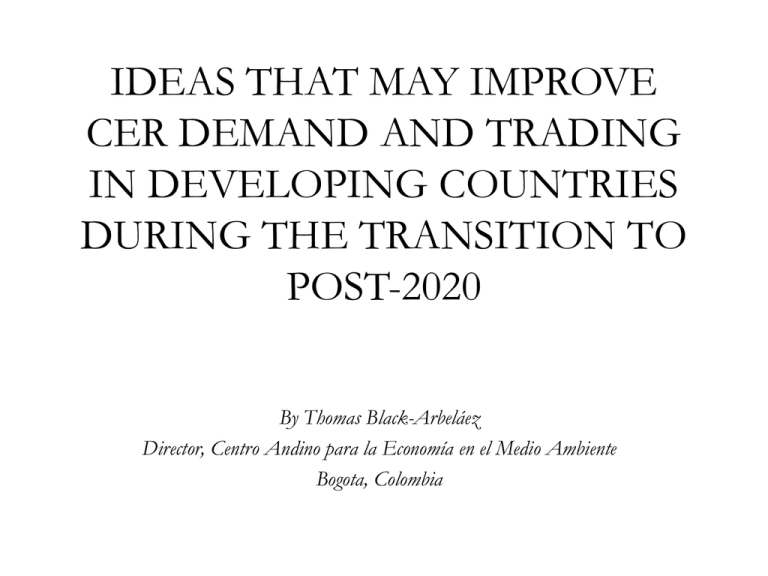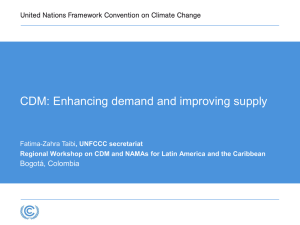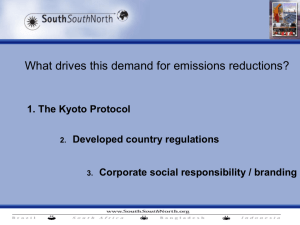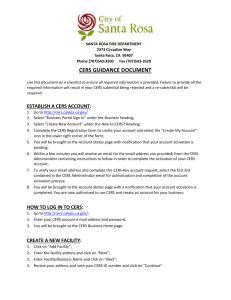COULD CLEARER, FIRMER PRICE SIGNALS IMPROVE CER
advertisement

IDEAS THAT MAY IMPROVE CER DEMAND AND TRADING IN DEVELOPING COUNTRIES DURING THE TRANSITION TO POST-2020 By Thomas Black-Arbeláez Director, Centro Andino para la Economía en el Medio Ambiente Bogota, Colombia • Demand from industrialized nations could return but is probably several years away- post 2020. • ….emerging Chinese markets could possibly absorb significant amounts of CERs by converting UNFCCC CERs to Chinese CERs • … Obama administration program to force US States to impose emissions caps and allow them flexibility to choose their preferred compliance strategy could possibly demand CERs…. What we have pre-2020 in Latin America: voluntary markets • • • • … highly fractured demand … niches with widely varied preferences, … generating small transaction volumes, … with a focus on project attributes instead of carbon, • ….that generates no clear, single, carbon price signal. “demand continues to rest with those actors that have the desire and discretionary income to voluntarily purchase offsets. This represents a small number of buyers and transactions. In comparison to more active marketplaces, voluntary buyers are not always at hand and offset prices are highly stratified and unpredictable, even within similar classes of offsets”. State of the Voluntary Carbon Markets 2013, P.8. Source: State of the Voluntary Carbon Markets 2013, p.26. HTTP://W W W .FOREST-TRENDS.ORG /DOCUMENTS/FILES/DOC _3898.PDF “Willing and Able” Buyers and Sellers face the Price Uncertainty Problem • In the attribute-based world of voluntary markets, price reports are often confusing instead of clarifying. • The transactions and marketing costs of attribute based carbon trading are much higher than a single priced carbon market. • For a project owner willing and able to sell, this information suggests that a “successful” trade should be realized near the top of the reported price range. • For the CER buyer, this price information leads to believing that a “successful” trade should be realized near the lower end of the reported range for his project type. • When OTC negotiations reveal the widely differing price expectations, uncertainty grows and frustration can easily ensue. • For both seller and buyer, it is safer to postpone the trade until future market conditions permit a safer decision. FIRST-BEST OPTIONS TO INCREASE DEMAND AND TRADING IN CERS • • • • Domestic, country-wide cap and trade programs, Regional or sectoral cap and trade programs, A Carbon Tax on emissions, Domestic carbon “tax and trade” programs, such as the South African and Mexican models. • However, in many developing countries, imposing a compliance based carbon price through taxation of emissions, or a cap and trade system, may not be feasible in the short to medium term ELEMENTS TO BUILD UPON • Climate change awareness at every level of society in Latin America – the media is strong proponent • Corporate carbon footprinting and sustainability policies have become commonplace today • Many government institutions are also following suit with public sector footprinting. • The Low Emissions Development Strategies (LEDS) teams are generating important and useful information. – a realistic estimation of current abatement options and marginal costs of mitigation; sectoral and national MACs • Purchasing and Cancelling CERs from the CDM registry now has two benefits to incorporate all of society: – CERs are affordable to all – Cancelation from the Registry is simple and straightforward. A SECOND BEST OPTION TO INCREASE CER TRADING: A GOVERNMENT-PROMOTED INDICATIVE PRICE OF CARBON • If governments cannot implement a compliance-based carbon tax or cap and trade system for any reason, • Could implement an INDICATIVE PRICE OF CARBON and vigorously promote voluntary purchases of CERS to offset carbon footprints in both the public and private sectors. • The INDICATIVE PRICE OF CARBON would be continuously published along with the other leading price indicators by the news media, financial web pages, government publications, and mobile applications. • Public and private entities could quickly reference the clear, single price of domestic carbon, • eliminating the price uncertainty for buyers and sellers that are willing and able to trade. This “indicative single domestic carbon” could be easily constructed. • First, key stakeholders of the public and private sectors would meet yearly to determine a voluntary national carbon reduction target. • By subtracting the agreed target level of emissions from the current year -to -2020 emissions levels, the annual amount of GHG reduction required can be calculated. A Voluntary National Reduction Target Negotiated by C urrent National Emissions in Tons C O2e Voluntary National Mitigation Target 1990 level Required annual reduction Stakeholders 100,000,000 90,000,000 10,000,000 • Second Step: use the national marginal abatement cost curve produced by the domestic LEDS team • estimate the cost per ton reduced of the marginal mitigation option necessary to reach the required annual reduction: 10 Mn tons • In the following example, the Indicative Carbon Price would be US$5. MAC derived from domestic LEDS work indicating that the marginal cost of abatement to reduce 10 million tons C O2e per y ear is $5 dollars per ton reduced. This is the indicative carbon price level for this country , reflecting its individual context, conditions and specific abatement options. A Strong Promotional Program by each Participating Government would be Needed • Managing the market psychology of this approach is of great importance. • A vigorous reporting program for Price Indicators would be required - the Indicative Carbon Price should be reported in all media along with other leading price indicators – coal, oil, energy, agricultural commodities, dollar and euro exchange rates. It should be reported in the newspapers, on the economic news on the radio and television, on relevant web pages, and through mobile applications. • The government would have to promote both the indicative carbon price and the practice of voluntary carbon offsetting • Government would have to continuously encourage the public sector, private firms and citizens to voluntarily contribute to the mitigation effort through the purchase of CERs. Complementary Policies • Government policy to require public sector footprinting at all levels of government. • Introduce Public Disclosure Programs to monitor, rank and report public sector annual improvements on emissions (“Greening Industry, Indonesia, WB) • Improve and clarify tax benefits for corporations and citizens: modify the tax code so that corporations and private citizens can obtain clear tax benefits when they purchase CERs and cancel them at UNFCCC, as eligible environmental donations or investments. What can be expected in terms of real increased CER demand? • This can only be learned from trial and observance. • It would depend on many factors, particularly on the strength and consistency of the Government promotion program by government, acceptance and promotion by the news media, producer associations, and leading NGOs. • But considering the state of CER demand to date, this may be worth a try. Thank you for your attention. IDEAS THAT MAY IMPROVE CER DEMAND AND TRADING IN DEVELOPING COUNTRIES DURING THE TRANSITION TO POST-2020 By Thomas Black-Arbeláez Director, Centro Andino para la Economía en el Medio Ambiente Bogota, Colombia www.andeancenter.com thomas.black.a@gmail.com











